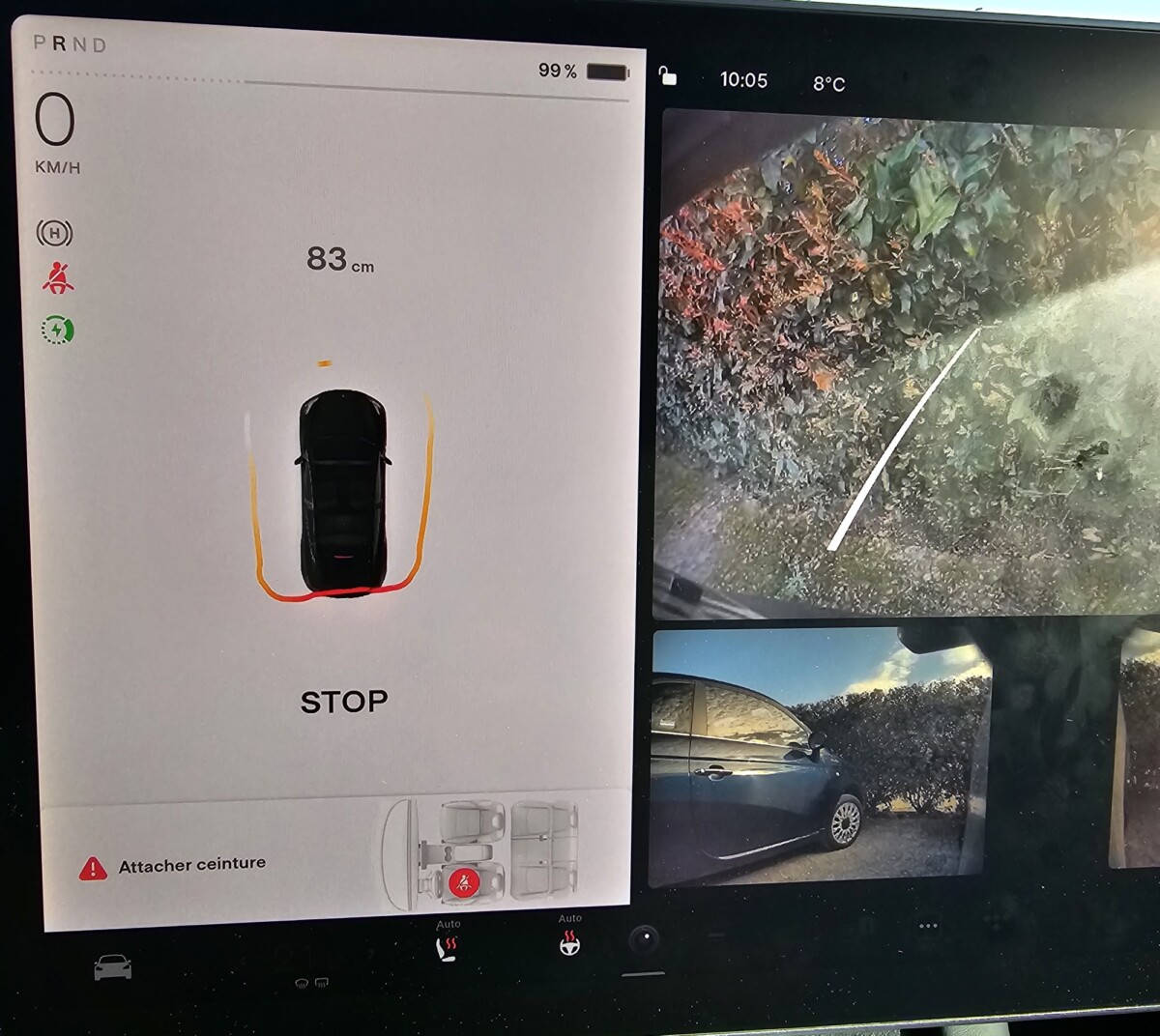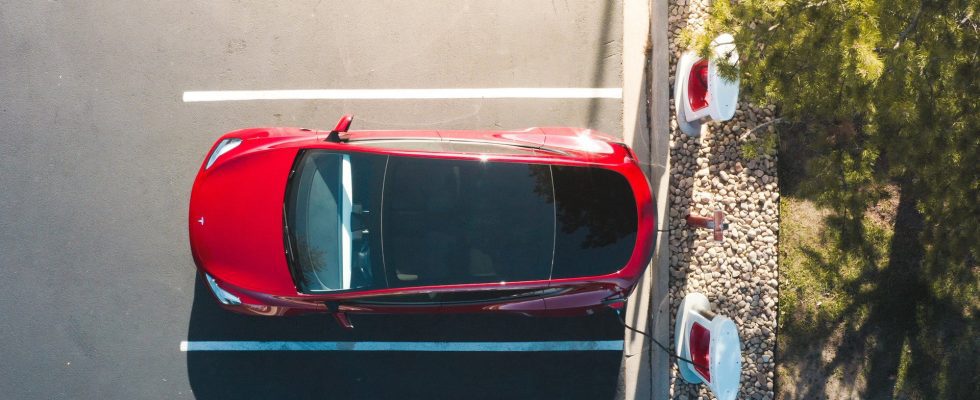A long-awaited new update has just arrived on Teslas without ultrasonic sensors (USS), allowing better parking, thanks to Tesla Vision. Well, that’s the theory. In practice, this solution, called Tesla Vision Parking Assist, based on cameras can be greatly improved. Let’s take stock of what is working and what is not.
The famous update that restores parking aids for Teslas that are not equipped with ultrasonic sensors has arrived in France. This version 2023.6.9 indeed brings a novelty that we have been waiting for since September 2022, a little over six months.
Some were placing high hopes on this feature, and essentially imagined that the camera-based solution would do better than the proximity sensors were capable of. Of course, we could imagine certain physical limitations in advance, when visibility is reduced for example. But even when all is well externally, can you trust Tesla Vision to park?
We are going to go into more detail on what was promised by Tesla, what is indeed being offered at the moment, and will come back to the operation of the ultrasonic sensors which were not perfect either. Finally, we will see if Tesla has the possibility of drastically improving Tesla Vision for parking, or if we are condemned to have to deal with the current imperfection. ad vitam aeternam.
Tesla Vision for parking: a promise written six months ago
On the Tesla site, we can still read the following text:
In the near future, once these features have reached the same performance levels as in current vehicles, they will be restored via a series of over-the-air software updates.
Considering that the 2022.6.9 update brings parking assistance via Tesla Vision, is that the manufacturer considers that this has reached the same level of performance as vehicles equipped with ultrasonic sensors.
What’s called “Park Assist” isn’t the only feature that Tesla has removed from vehicles that shipped without ultrasonic sensors, but it’s the only one that’s returned for now. Auto Park, Auto Exit and Smart Auto Exit are still unavailable to date for vehicles that have the corresponding options.
If the first tests of Park Assist via Tesla Vision seemed promising, now that we have it on our vehicles, it is time to examine what it gives in practice, in classic situations.
The theory of Tesla Vision facing physical limits
The value of parking assistance depends on its reliability
. Indeed, how can you trust a system that provides inaccurate information, either because the distances are overestimated, or because an obstacle is not detected? This is the whole challenge that awaits Tesla Vision, since physical limits do seem to exist.
Indeed, the very placement of the cameras on the Tesla makes certain places near the vehicle invisible, and without movement it is therefore not possible to determine the placement of surrounding objects. Specifically, what is at a distance of less than a meter from the front bumper, and less than fifty centimeters high is completely invisible to the three cameras located at the top of the windshield.

Hardware 4, which is also highly anticipated, could make it possible to overcome this blind spot, if cameras are indeed installed on the front bumper. But as it is, there is no miracle, Tesla can’t make up for the lack of visibility due to the placement of its front cameras right now.
The theory of Tesla Vision is therefore to rely on an occupation network based on cameras, to both identify objects, differentiate them, but also refine the positioning of the vehicle in space.
In other words, it must make it possible to measure at what distance the surrounding objects are located, but also where and how your Tesla is positioned in relation to what surrounds it. Let’s see if this promise is fulfilled in practice in different situations.
Useful parking assistance or gadget?
The first test of whether or not Tesla Vision can be trusted for parking is simple: does it see the environment correctly, reliably? Under normal, daytime conditions, the answer is usually yes. For example, you can see below what a Tesla Model Y Propulsion is telling us, parked in reverse against a hedge, between two cars.

The lines symbolize the close environment on both sides of the vehicle, and the indication of 83 centimeters forward is quite reliable, since at the level of the orange line there is a person standing, visible to the cameras. A first failure, however, points the tip of his nose at the back : the red line seems to be inside the vehicle, as if we were backed up against the hedge, while there are still more than 15 centimeters before coming into contact with it.
The rear camera therefore remains your best ally for reversing maneuvers in a Tesla, because it makes it easier to see where the obstacle is behind than the lines drawn by Tesla Vision on the left side of the screen. Of course, this is only valid when the camera is clean, otherwise it is of no help. But in this specific case, a message will appear on the screen, indicating that the parking assistance (which is based on the cameras) is also unavailable.
A case that cannot really arise with ultrasonic sensors, since they are much less sensitive to dirt.
We understand that in some cases park assist won’t be available, but when it is, can you really trust it? We have tested several situations and it is unfortunately quite simple to fault the Tesla Vision system. Note that if you are bothered by the famous untimely and unhelpful “beep beep” of this parking aid, you can deactivate in the corresponding menu.
The vision-based occupancy network will attempt to guess not only the placement of a curb, but also its height, while it is not visible to cameras. Thus, parking in forward gear with a sidewalk 15 centimeters high will sometimes turn into a wall several tens of centimeters high, much closer than in reality, when imagined by Tesla Vision.
A few tests show the current limits of Tesla Vision
We paid the price during our tests, as you can see from the Tweet below, where we decided to trust the parking assistance when it indicated that we should not get any closer than the present obstacle.
I stopped it when it said “STOP”.
Hyper perfected and infallible system. pic.twitter.com/giCcQHOPUm
— Bob Jouy (@bobjouy) March 28, 2023
Unlike reverse gear where a second check can be made using the camera, in the case of forward gear, we have no other way to see what’s in front of the bumper than from our vantage point. Of course, without parking assistance, we would have advanced much further than in the photo, but what to do when the vehicle tells you to stop so as not to hit an obstacle?
Trust in Tesla Vision for parking assistance is therefore greatly shaken after these few days of testing, but let’s salute one thing all the same: for the moment, Tesla Vision often seems to be overly cautious, and not the other way around.
Indeed, it would be much more serious to have undetected obstacles, where one would imagine in essence being able to continue to move forward, because the vehicle does not indicate any surrounding danger, and in the end hit an invisible object. Unfortunately, although less common, this case happens in certain situationsso pay attention to what the on-board computer displays.
But as it is, forward and reverse, stopping when suggested will get you out of your Tesla, then move it forwards or backwards so far from your ideal position. In practice, the distance indications stop at 30 centimeters, following which the indication “STOP” appears, which can be anxiety-provoking. But this is also the case with Teslas equipped with ultrasonic sensors.
If for that matter you attempt to trust your car on a Supercharger while backing up, you will find yourself probably too far terminal to be able to connect, which is still funny. Unless it is a V4 terminal, with its much longer cable.
And this is what it looks like on video. pic.twitter.com/wyJc1D5ibt
— Bob Jouy (@bobjouy) March 29, 2023
Finally, when you restart your Tesla which was parked, the Tesla Vision parking aid is unavailable for long seconds, while waiting to retrieve the last information recorded on the nearby environment.
You would have understood it, the parking assistance offered by Tesla Vision today is largely perfectible, but what about ultrasonic sensors? We will see that there were also situations where the latter were not that useful.
Were ultrasonic sensors better?
So the real question now that Tesla Vision for parking is available is: compared to ultrasonic sensors, under comparable conditions, how do the two solutions compare? It is important to keep in mind that ultrasonic sensors are not a 100% trustworthy solution, as you can see in the video below.
Hot Opinion: Ultrasonic Sensors Are Not Useful. pic.twitter.com/yn1Z2SFzXZ
— Bob Jouy (@bobjouy) November 18, 2022
In this everyday situation where we enter a Tesla Model 3 in our garage, the ultrasonic sensors therefore give no relevant information, since they regularly indicate an erroneous distance on the left part of the screen of the car.
However, we can still notice many cases where ultrasonic sensors are still better than Tesla Vision at present. First of all, ultrasonic sensors are not dependent on light or weather conditions. This means that when the cameras are wet or dirty in particular, the parking aids via Tesla Vision are unavailable, while the ultrasonic sensors work nominally.
Finally, during the more conventional maneuvers of approaching a wall in forward or reverse gear, the ultrasonic sensors offer more precision than Tesla Vision and its approximate display. This is easily understandable, since on the one hand the distance is estimated using cameras, and on the other, it is simply a precise calculation thanks to dedicated sensors. A common point that we find however between the two solutions: there is no measurement under 30 centimeters. In other words, if you want to approach an obstacle within 30 centimeters in forward or reverse gear, you will only see the indication “STOP” on the screen, with or without ultrasonic sensors.

Although one can expect the Tesla Vision to improve over time, one has to moderate one’s expectations so as not to be disappointed. In effect, it is very likely that the current implementation will not evolve or very little, so many physical limitations are what prevent the cameras from seeing properly in all circumstances. The famous hardware 4 will undoubtedly be what will solve everything for future Teslas, but for the current ones, we have to deal with this imperfect solution for the moment.
Do you use Google News (News in France)? You can follow your favorite media. Follow Frandroid on Google News (and Numerama).
